Personal Reflection: Creativity, Innovation & Design at RMIT
VerifiedAdded on 2023/03/31
|6
|1242
|67
Report
AI Summary
This document presents a student's reflective overview of a Creativity, Innovation & Design course, detailing their initial expectations, how the course impacted their views, and the knowledge and skills acquired. The reflection highlights learning outcomes related to the creative process, team formation, design thinking, and idea generation. It includes an example of how the student applied course learnings to solve a real-life problem, supported by scholarly research. The paper also touches upon ethical considerations in creativity and innovation, the impact of globalization, and the importance of sustainable development. The student concludes with a desire to apply these learnings through an internship, aiming for practical experience to complement the theoretical knowledge gained.
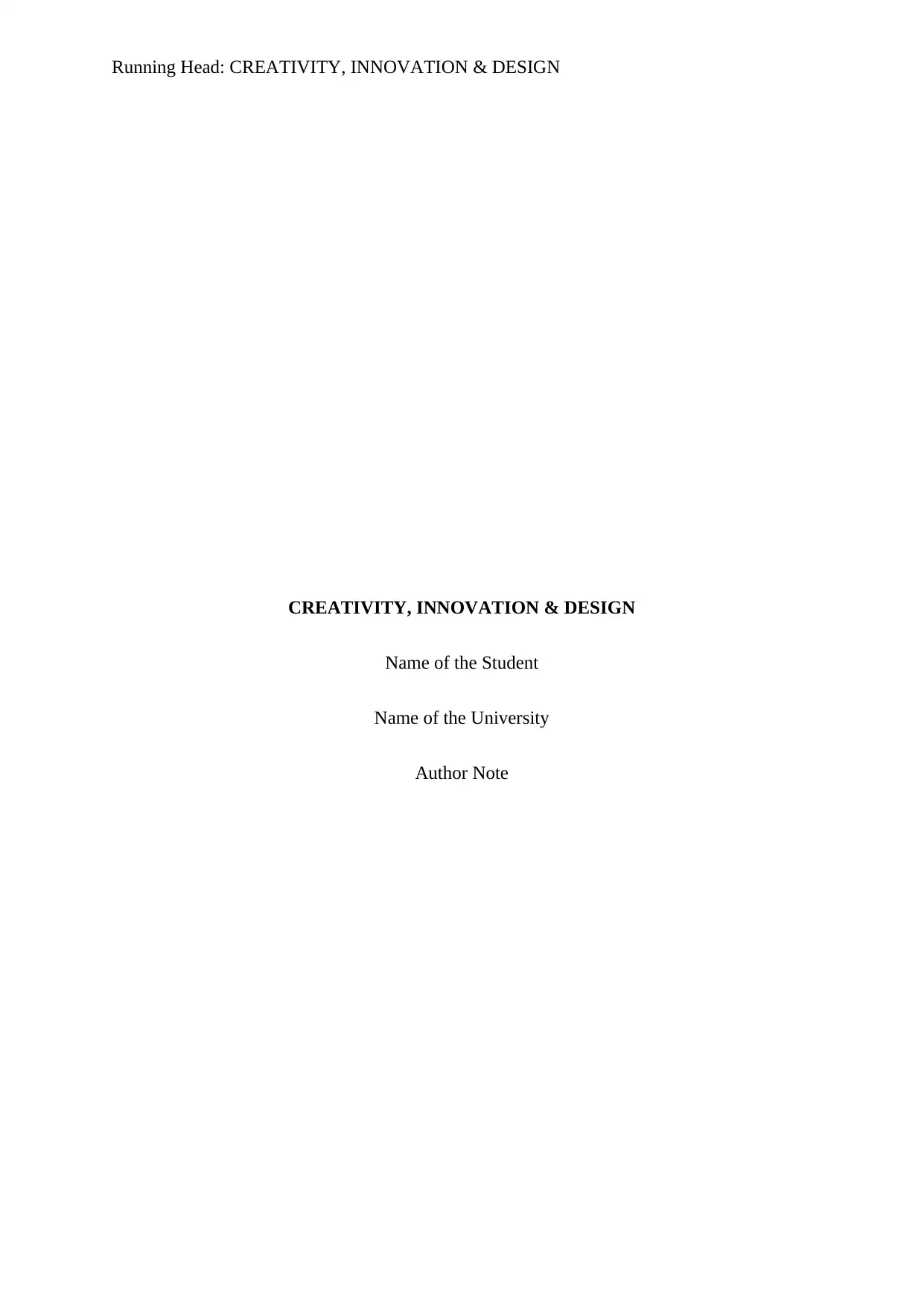
Running Head: CREATIVITY, INNOVATION & DESIGN
CREATIVITY, INNOVATION & DESIGN
Name of the Student
Name of the University
Author Note
CREATIVITY, INNOVATION & DESIGN
Name of the Student
Name of the University
Author Note
Paraphrase This Document
Need a fresh take? Get an instant paraphrase of this document with our AI Paraphraser
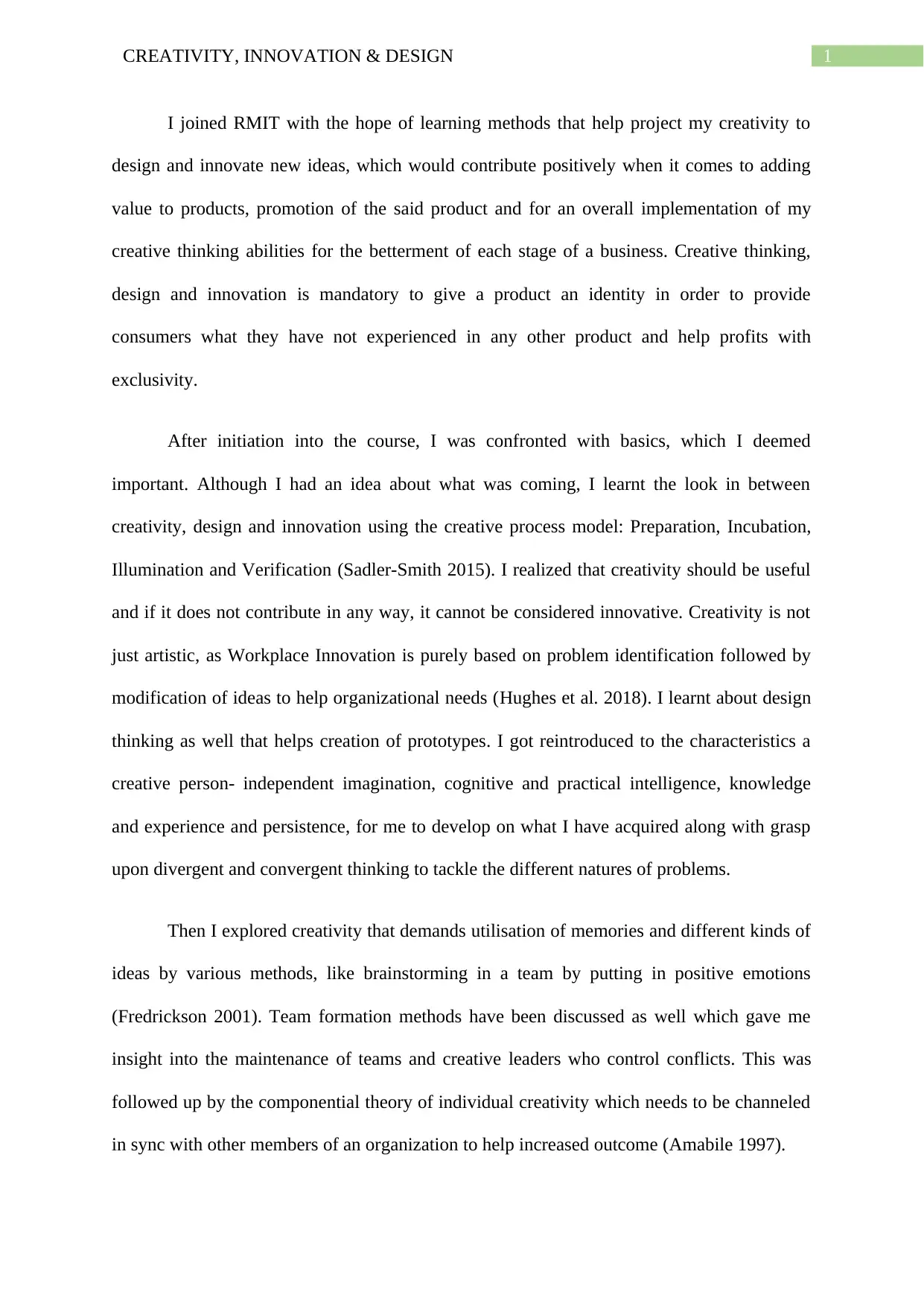
1CREATIVITY, INNOVATION & DESIGN
I joined RMIT with the hope of learning methods that help project my creativity to
design and innovate new ideas, which would contribute positively when it comes to adding
value to products, promotion of the said product and for an overall implementation of my
creative thinking abilities for the betterment of each stage of a business. Creative thinking,
design and innovation is mandatory to give a product an identity in order to provide
consumers what they have not experienced in any other product and help profits with
exclusivity.
After initiation into the course, I was confronted with basics, which I deemed
important. Although I had an idea about what was coming, I learnt the look in between
creativity, design and innovation using the creative process model: Preparation, Incubation,
Illumination and Verification (Sadler-Smith 2015). I realized that creativity should be useful
and if it does not contribute in any way, it cannot be considered innovative. Creativity is not
just artistic, as Workplace Innovation is purely based on problem identification followed by
modification of ideas to help organizational needs (Hughes et al. 2018). I learnt about design
thinking as well that helps creation of prototypes. I got reintroduced to the characteristics a
creative person- independent imagination, cognitive and practical intelligence, knowledge
and experience and persistence, for me to develop on what I have acquired along with grasp
upon divergent and convergent thinking to tackle the different natures of problems.
Then I explored creativity that demands utilisation of memories and different kinds of
ideas by various methods, like brainstorming in a team by putting in positive emotions
(Fredrickson 2001). Team formation methods have been discussed as well which gave me
insight into the maintenance of teams and creative leaders who control conflicts. This was
followed up by the componential theory of individual creativity which needs to be channeled
in sync with other members of an organization to help increased outcome (Amabile 1997).
I joined RMIT with the hope of learning methods that help project my creativity to
design and innovate new ideas, which would contribute positively when it comes to adding
value to products, promotion of the said product and for an overall implementation of my
creative thinking abilities for the betterment of each stage of a business. Creative thinking,
design and innovation is mandatory to give a product an identity in order to provide
consumers what they have not experienced in any other product and help profits with
exclusivity.
After initiation into the course, I was confronted with basics, which I deemed
important. Although I had an idea about what was coming, I learnt the look in between
creativity, design and innovation using the creative process model: Preparation, Incubation,
Illumination and Verification (Sadler-Smith 2015). I realized that creativity should be useful
and if it does not contribute in any way, it cannot be considered innovative. Creativity is not
just artistic, as Workplace Innovation is purely based on problem identification followed by
modification of ideas to help organizational needs (Hughes et al. 2018). I learnt about design
thinking as well that helps creation of prototypes. I got reintroduced to the characteristics a
creative person- independent imagination, cognitive and practical intelligence, knowledge
and experience and persistence, for me to develop on what I have acquired along with grasp
upon divergent and convergent thinking to tackle the different natures of problems.
Then I explored creativity that demands utilisation of memories and different kinds of
ideas by various methods, like brainstorming in a team by putting in positive emotions
(Fredrickson 2001). Team formation methods have been discussed as well which gave me
insight into the maintenance of teams and creative leaders who control conflicts. This was
followed up by the componential theory of individual creativity which needs to be channeled
in sync with other members of an organization to help increased outcome (Amabile 1997).
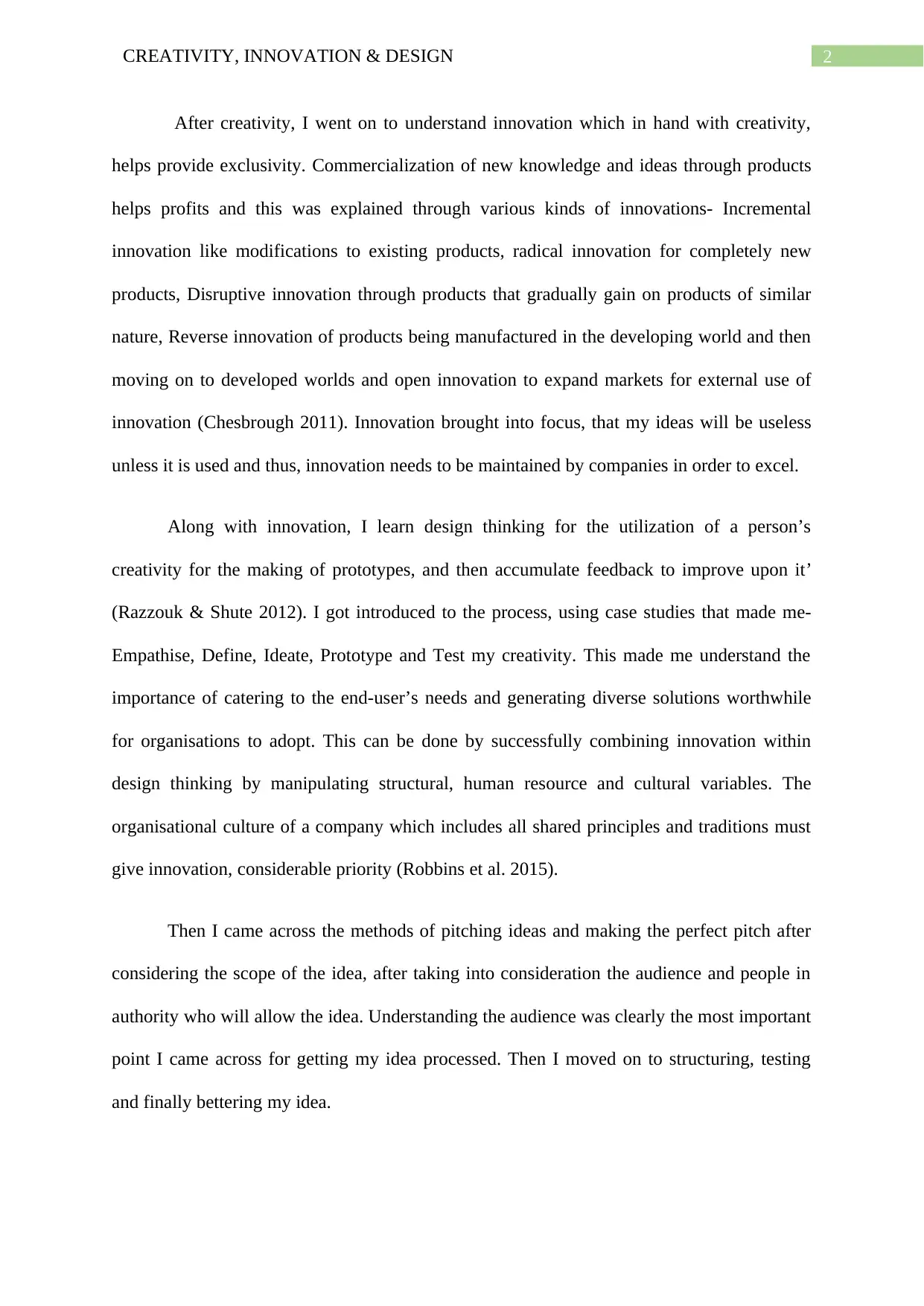
2CREATIVITY, INNOVATION & DESIGN
After creativity, I went on to understand innovation which in hand with creativity,
helps provide exclusivity. Commercialization of new knowledge and ideas through products
helps profits and this was explained through various kinds of innovations- Incremental
innovation like modifications to existing products, radical innovation for completely new
products, Disruptive innovation through products that gradually gain on products of similar
nature, Reverse innovation of products being manufactured in the developing world and then
moving on to developed worlds and open innovation to expand markets for external use of
innovation (Chesbrough 2011). Innovation brought into focus, that my ideas will be useless
unless it is used and thus, innovation needs to be maintained by companies in order to excel.
Along with innovation, I learn design thinking for the utilization of a person’s
creativity for the making of prototypes, and then accumulate feedback to improve upon it’
(Razzouk & Shute 2012). I got introduced to the process, using case studies that made me-
Empathise, Define, Ideate, Prototype and Test my creativity. This made me understand the
importance of catering to the end-user’s needs and generating diverse solutions worthwhile
for organisations to adopt. This can be done by successfully combining innovation within
design thinking by manipulating structural, human resource and cultural variables. The
organisational culture of a company which includes all shared principles and traditions must
give innovation, considerable priority (Robbins et al. 2015).
Then I came across the methods of pitching ideas and making the perfect pitch after
considering the scope of the idea, after taking into consideration the audience and people in
authority who will allow the idea. Understanding the audience was clearly the most important
point I came across for getting my idea processed. Then I moved on to structuring, testing
and finally bettering my idea.
After creativity, I went on to understand innovation which in hand with creativity,
helps provide exclusivity. Commercialization of new knowledge and ideas through products
helps profits and this was explained through various kinds of innovations- Incremental
innovation like modifications to existing products, radical innovation for completely new
products, Disruptive innovation through products that gradually gain on products of similar
nature, Reverse innovation of products being manufactured in the developing world and then
moving on to developed worlds and open innovation to expand markets for external use of
innovation (Chesbrough 2011). Innovation brought into focus, that my ideas will be useless
unless it is used and thus, innovation needs to be maintained by companies in order to excel.
Along with innovation, I learn design thinking for the utilization of a person’s
creativity for the making of prototypes, and then accumulate feedback to improve upon it’
(Razzouk & Shute 2012). I got introduced to the process, using case studies that made me-
Empathise, Define, Ideate, Prototype and Test my creativity. This made me understand the
importance of catering to the end-user’s needs and generating diverse solutions worthwhile
for organisations to adopt. This can be done by successfully combining innovation within
design thinking by manipulating structural, human resource and cultural variables. The
organisational culture of a company which includes all shared principles and traditions must
give innovation, considerable priority (Robbins et al. 2015).
Then I came across the methods of pitching ideas and making the perfect pitch after
considering the scope of the idea, after taking into consideration the audience and people in
authority who will allow the idea. Understanding the audience was clearly the most important
point I came across for getting my idea processed. Then I moved on to structuring, testing
and finally bettering my idea.
⊘ This is a preview!⊘
Do you want full access?
Subscribe today to unlock all pages.

Trusted by 1+ million students worldwide
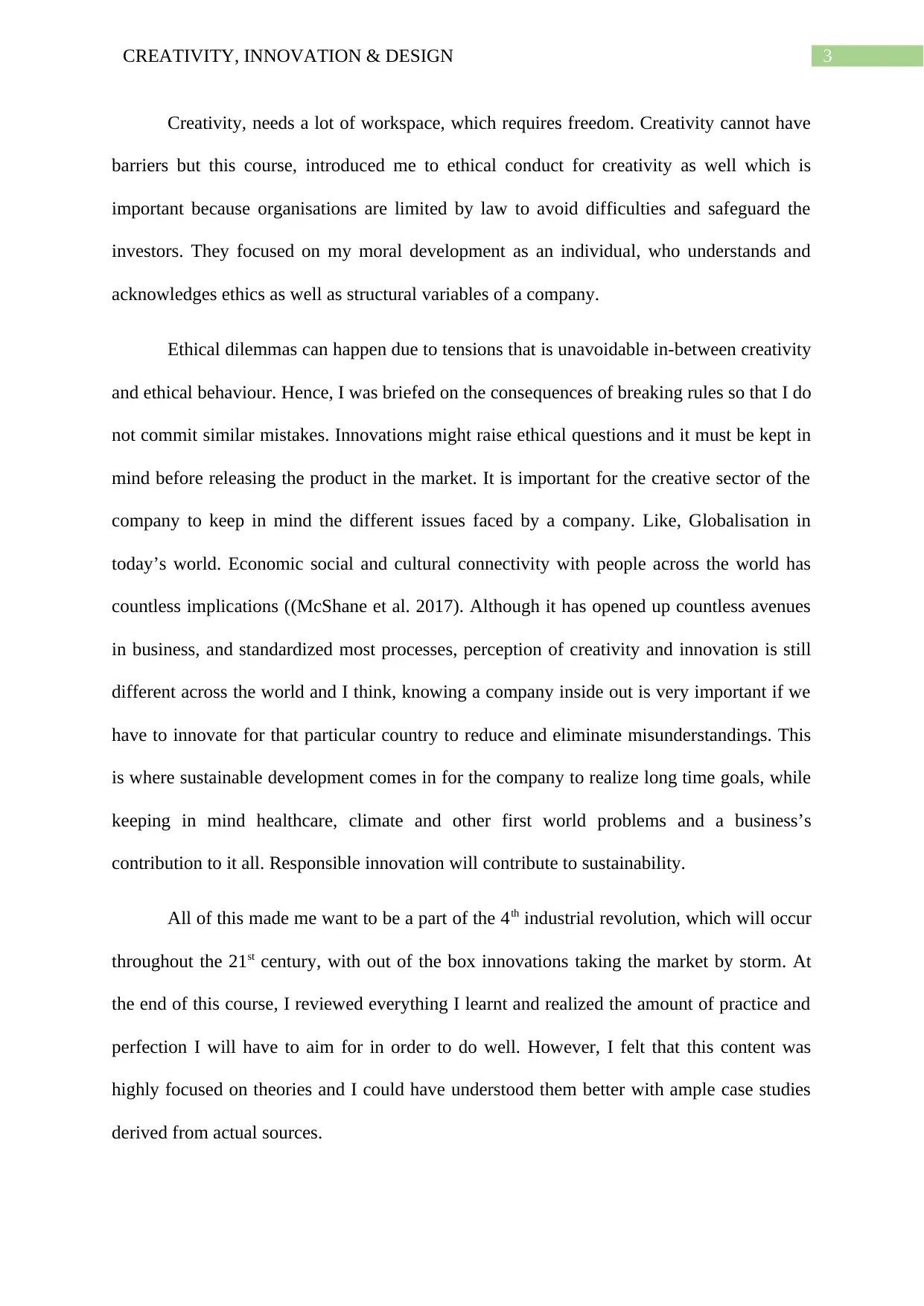
3CREATIVITY, INNOVATION & DESIGN
Creativity, needs a lot of workspace, which requires freedom. Creativity cannot have
barriers but this course, introduced me to ethical conduct for creativity as well which is
important because organisations are limited by law to avoid difficulties and safeguard the
investors. They focused on my moral development as an individual, who understands and
acknowledges ethics as well as structural variables of a company.
Ethical dilemmas can happen due to tensions that is unavoidable in-between creativity
and ethical behaviour. Hence, I was briefed on the consequences of breaking rules so that I do
not commit similar mistakes. Innovations might raise ethical questions and it must be kept in
mind before releasing the product in the market. It is important for the creative sector of the
company to keep in mind the different issues faced by a company. Like, Globalisation in
today’s world. Economic social and cultural connectivity with people across the world has
countless implications ((McShane et al. 2017). Although it has opened up countless avenues
in business, and standardized most processes, perception of creativity and innovation is still
different across the world and I think, knowing a company inside out is very important if we
have to innovate for that particular country to reduce and eliminate misunderstandings. This
is where sustainable development comes in for the company to realize long time goals, while
keeping in mind healthcare, climate and other first world problems and a business’s
contribution to it all. Responsible innovation will contribute to sustainability.
All of this made me want to be a part of the 4th industrial revolution, which will occur
throughout the 21st century, with out of the box innovations taking the market by storm. At
the end of this course, I reviewed everything I learnt and realized the amount of practice and
perfection I will have to aim for in order to do well. However, I felt that this content was
highly focused on theories and I could have understood them better with ample case studies
derived from actual sources.
Creativity, needs a lot of workspace, which requires freedom. Creativity cannot have
barriers but this course, introduced me to ethical conduct for creativity as well which is
important because organisations are limited by law to avoid difficulties and safeguard the
investors. They focused on my moral development as an individual, who understands and
acknowledges ethics as well as structural variables of a company.
Ethical dilemmas can happen due to tensions that is unavoidable in-between creativity
and ethical behaviour. Hence, I was briefed on the consequences of breaking rules so that I do
not commit similar mistakes. Innovations might raise ethical questions and it must be kept in
mind before releasing the product in the market. It is important for the creative sector of the
company to keep in mind the different issues faced by a company. Like, Globalisation in
today’s world. Economic social and cultural connectivity with people across the world has
countless implications ((McShane et al. 2017). Although it has opened up countless avenues
in business, and standardized most processes, perception of creativity and innovation is still
different across the world and I think, knowing a company inside out is very important if we
have to innovate for that particular country to reduce and eliminate misunderstandings. This
is where sustainable development comes in for the company to realize long time goals, while
keeping in mind healthcare, climate and other first world problems and a business’s
contribution to it all. Responsible innovation will contribute to sustainability.
All of this made me want to be a part of the 4th industrial revolution, which will occur
throughout the 21st century, with out of the box innovations taking the market by storm. At
the end of this course, I reviewed everything I learnt and realized the amount of practice and
perfection I will have to aim for in order to do well. However, I felt that this content was
highly focused on theories and I could have understood them better with ample case studies
derived from actual sources.
Paraphrase This Document
Need a fresh take? Get an instant paraphrase of this document with our AI Paraphraser
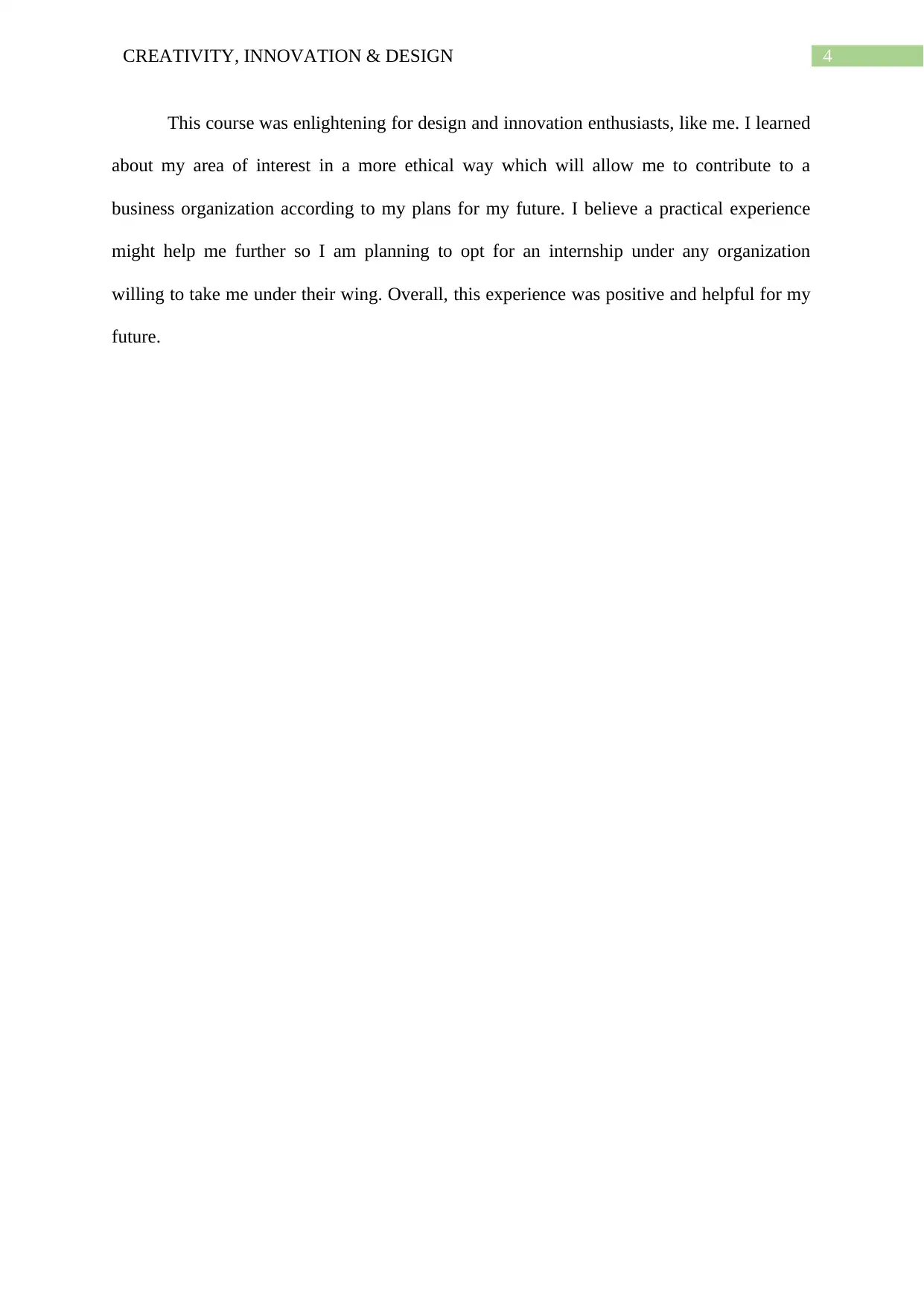
4CREATIVITY, INNOVATION & DESIGN
This course was enlightening for design and innovation enthusiasts, like me. I learned
about my area of interest in a more ethical way which will allow me to contribute to a
business organization according to my plans for my future. I believe a practical experience
might help me further so I am planning to opt for an internship under any organization
willing to take me under their wing. Overall, this experience was positive and helpful for my
future.
This course was enlightening for design and innovation enthusiasts, like me. I learned
about my area of interest in a more ethical way which will allow me to contribute to a
business organization according to my plans for my future. I believe a practical experience
might help me further so I am planning to opt for an internship under any organization
willing to take me under their wing. Overall, this experience was positive and helpful for my
future.
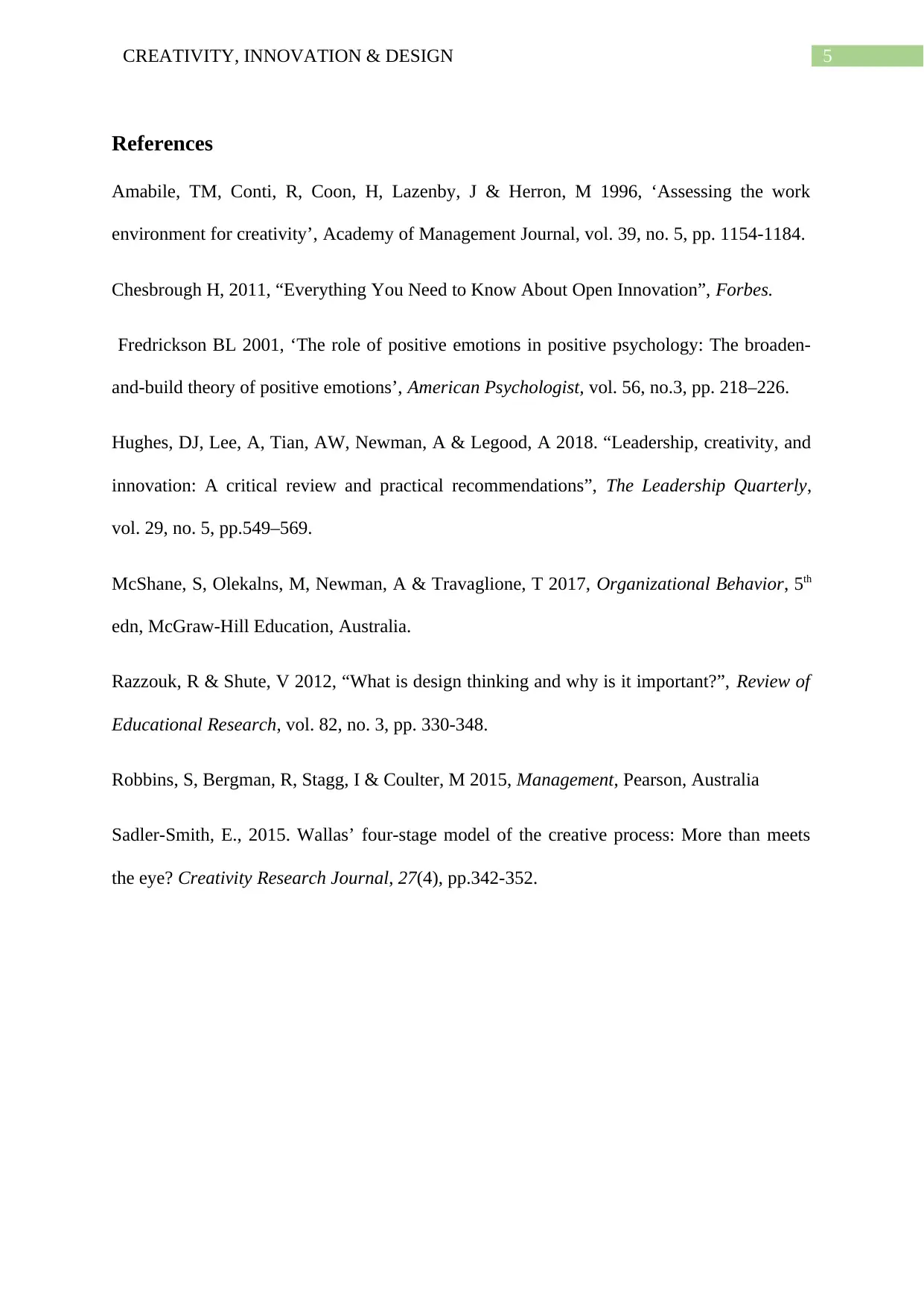
5CREATIVITY, INNOVATION & DESIGN
References
Amabile, TM, Conti, R, Coon, H, Lazenby, J & Herron, M 1996, ‘Assessing the work
environment for creativity’, Academy of Management Journal, vol. 39, no. 5, pp. 1154-1184.
Chesbrough H, 2011, “Everything You Need to Know About Open Innovation”, Forbes.
Fredrickson BL 2001, ‘The role of positive emotions in positive psychology: The broaden-
and-build theory of positive emotions’, American Psychologist, vol. 56, no.3, pp. 218–226.
Hughes, DJ, Lee, A, Tian, AW, Newman, A & Legood, A 2018. “Leadership, creativity, and
innovation: A critical review and practical recommendations”, The Leadership Quarterly,
vol. 29, no. 5, pp.549–569.
McShane, S, Olekalns, M, Newman, A & Travaglione, T 2017, Organizational Behavior, 5th
edn, McGraw-Hill Education, Australia.
Razzouk, R & Shute, V 2012, “What is design thinking and why is it important?”, Review of
Educational Research, vol. 82, no. 3, pp. 330-348.
Robbins, S, Bergman, R, Stagg, I & Coulter, M 2015, Management, Pearson, Australia
Sadler-Smith, E., 2015. Wallas’ four-stage model of the creative process: More than meets
the eye? Creativity Research Journal, 27(4), pp.342-352.
References
Amabile, TM, Conti, R, Coon, H, Lazenby, J & Herron, M 1996, ‘Assessing the work
environment for creativity’, Academy of Management Journal, vol. 39, no. 5, pp. 1154-1184.
Chesbrough H, 2011, “Everything You Need to Know About Open Innovation”, Forbes.
Fredrickson BL 2001, ‘The role of positive emotions in positive psychology: The broaden-
and-build theory of positive emotions’, American Psychologist, vol. 56, no.3, pp. 218–226.
Hughes, DJ, Lee, A, Tian, AW, Newman, A & Legood, A 2018. “Leadership, creativity, and
innovation: A critical review and practical recommendations”, The Leadership Quarterly,
vol. 29, no. 5, pp.549–569.
McShane, S, Olekalns, M, Newman, A & Travaglione, T 2017, Organizational Behavior, 5th
edn, McGraw-Hill Education, Australia.
Razzouk, R & Shute, V 2012, “What is design thinking and why is it important?”, Review of
Educational Research, vol. 82, no. 3, pp. 330-348.
Robbins, S, Bergman, R, Stagg, I & Coulter, M 2015, Management, Pearson, Australia
Sadler-Smith, E., 2015. Wallas’ four-stage model of the creative process: More than meets
the eye? Creativity Research Journal, 27(4), pp.342-352.
⊘ This is a preview!⊘
Do you want full access?
Subscribe today to unlock all pages.

Trusted by 1+ million students worldwide
1 out of 6
Related Documents
Your All-in-One AI-Powered Toolkit for Academic Success.
+13062052269
info@desklib.com
Available 24*7 on WhatsApp / Email
![[object Object]](/_next/static/media/star-bottom.7253800d.svg)
Unlock your academic potential
Copyright © 2020–2025 A2Z Services. All Rights Reserved. Developed and managed by ZUCOL.




